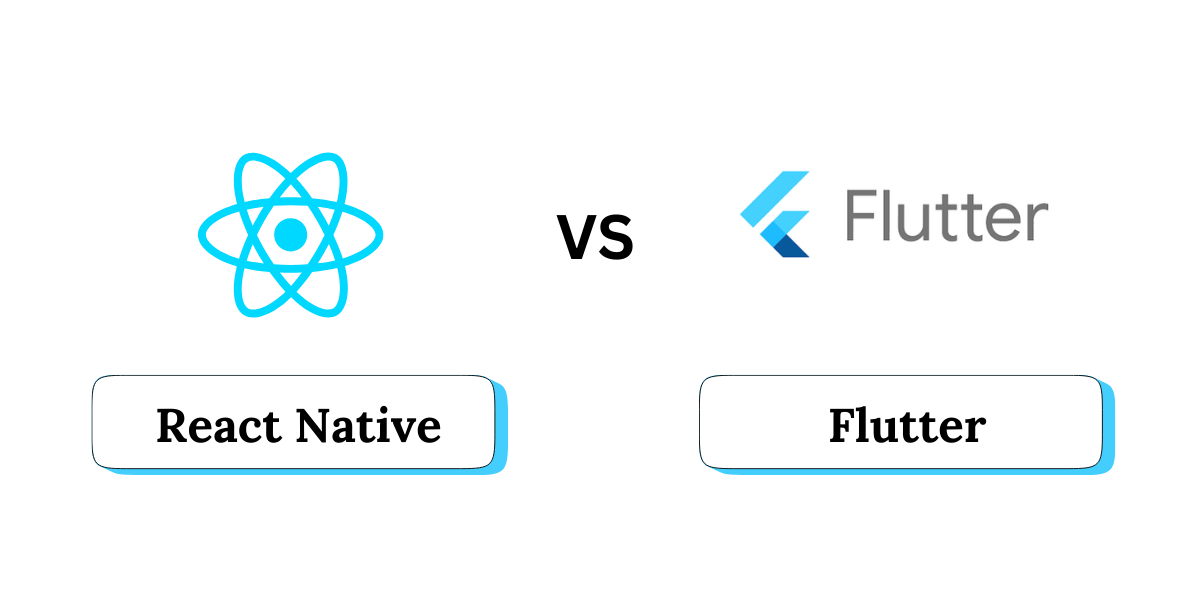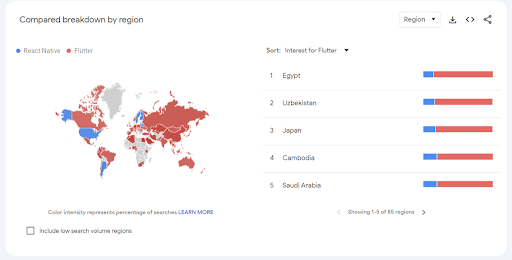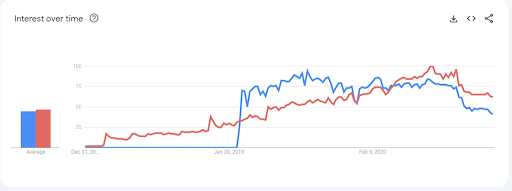React Native vs Flutter: Which One Should you Choose for your Next App?

Introduction
“React native if you’re getting started, want a job, and also want to learn backend with node and web development.”
And
“Flutter is generally preferred for faster development (leaving the code-formatting issues aside).”
The statements above reflect how most experienced app developers view the two leading frameworks—Flutter and React Native.
While they are insightful for developers, they may leave you, as a business owner, still wondering which is the right fit for your project. If you're struggling with this decision, you're in the right place. Keep reading to discover whether Flutter or React Native is the better choice for your app development needs.
Why is the React Native vs Flutter Comparison Still Relevant in 2024?
Even after several years, Flutter and React Native remain the top choices for hybrid app development. Ever since, the debate over which platform is superior, React Native or Flutter, has been ongoing, especially among developers on platforms like Reddit and Stack Overflow. While it's often viewed from a technical perspective, this discussion is equally important for business owners as it can have significant implications for project timelines, development costs, and scalability. Let’s move ahead with this context.
Commonalities between Flutter vs. React Native
Both platforms share several features, being top contenders in the application development space. Let’s look at some of these similarities.
1. Open-Source Nature: Both Flutter and React Native are freely available frameworks. There’s a large community of application developers contributing to improvements and newer versions, offering support, and providing learning resources.
2. Remarkable UI Capabilities: Both Flutter and React Native offer a range of UI components, allowing developers to create highly customizable, visually appealing interfaces. This gives your app a native-like look and feel, giving users a memorable experience.
3. Ease of Learning: Both Flutter and React Native are relatively easy to learn, especially for developers with experience in object-oriented programming. Flutter’s Dart has a gentle learning curve, and React Native is built on JavaScript, which many developers are already familiar with. This makes it quicker for teams to get up to speed and start building apps.
4. Widgets and Libraries: Flutter and React Native, both platforms offer a suite of unique widgets and libraries. Whether you’re working with Flutter’s customizable widgets or React Native’s reusable components, both help you develop sleek, functional apps with minimal hassle.
5. CI/CD Support: Automated application delivery and deployment is supported by both Flutter and React Native through CI/CD integration. App Developers can easily use tools like Fastlane or Codemagic to automate the testing, building, and deployment of apps, making the process smoother and more efficient.
Trends: Flutter vs React Native
Over the past five years, one clear trend has emerged: Flutter has captured a larger global market share compared to React Native. While Flutter's popularity spans across regions worldwide, React Native tends to be more dominant in Western countries.
Here is the regional search trend of Flutter vs. React Native.

Here is a generic overview of people’s interest in both technologies.

Looking deeper into the trends, one can see that the one year (2019-2020) was the year that shifted people’s perspective (as visible in the image below). React Native’s popularity and utility skyrocketed after a few major updates, including the introduction of the Hermes engine. This was a game-changer, particularly for Android apps, making React Native more competitive in terms of performance and reducing the JavaScript bridge-related delays. However, it wasn't too long before it started falling short again. Despite improvements like the Hermes engine, React Native still relied heavily on the JavaScript Bridge and focused primarily on iOS and Android. The focus was more on internal refactoring than expansion, delaying new features and development capabilities for users.

Post 2020, the trend has been pretty consistent—with Flutter being a preferred choice.
Let’s explore some key differences between Flutter vs. React Native in an attempt to understand what could be shaping these trends.
Flutter vs React Native Comparison: Key Differences
1. Based on Roles
|
For Developers One reason why Flutter is preferred for many hybrid app projects is Dart’s capability to provide just-in-time compilation during development and ahead-of-time compilation for producing machine code and deploying it. The framework also provides an extensive set of built-in widgets, minimizing the need for external libraries. This allows for a faster development process. On the other hand, developers familiar with JavaScript are more comfortable working with React Native. It has a huge ecosystem, allowing access to numerous third-party libraries and add-ons. However, it often requires bridging with native modules for complex features. |
For Designers Designers benefit from Flutter’s widget-based architecture, offering precise control over UI elements. Since Flutter doesn’t rely on native components, it allows for fully customized designs, which makes it easier for designers to implement unique, high-fidelity user interfaces. Conversely, React Native relies on native UI components. While this offers a more native-like look and feel, it can be a limitation for highly customized interfaces. This is why, many companies hire React Native app developers to bridge this gap through CSS-like styling using React Native’s StyleSheet. |
For Testers Testing in Flutter is comprehensive and internalized, with first-class support for unit, widget, and integration testing. It provides detailed documentation and a testing library to ensure smooth, automated testing processes for both functionality and UI. On the other hand, React Native-based testing is more fragmented. While unit testing can be done effectively using libraries like Jest and Mocha, UI and integration testing often require external tools such as Appium or Detox. Reliance on native components may cause testers to encounter platform-specific bugs more frequently, requiring additional platform-based testing. |
2. Performance
Flutter compiles directly to native ARM code via Dart's Ahead-of-Time (AOT) compilation. This results in faster startup times and smoother app performance. Its own Skia engine renders everything within itself, eliminating the need to bridge gaps between the app and native-like modules, providing consistent performance across platforms.
React Native uses JavaScript, which interacts with native modules through the JavaScript Bridge. The code is executed via JIT (Just-In-Time) compilation at runtime. This bridge can cause delays, especially with complex animations or computations, leading to slight performance overhead compared to Flutter’s native approach.
3. UI Rendering and Animation
Flutter’s UI rendering is highly efficient and internalized (through the Skia engine). The framework aims to deliver consistent, smooth 60fps animations across all platforms, even with highly complex custom UIs. Since Flutter avoids the overhead of converting UI components, it has a clear advantage when it comes to rendering heavy animations and giving you complete control over the app’s appearance.
Conversely, React Native’s reliance on native UI components makes the app feel more "native," but it introduces variability in performance between platforms. For complex applications and heavy UI loads, this can lead to performance issues if not optimized properly. However, recently introduced libraries (such as Reanimated and Gesture Handler) have improved React Native’s animation capabilities over the last few years.
4. Memory Usage
Flutter apps tend to use slightly more memory because of the Skia rendering engine and the large widget library. However, the optimized compilation and native ARM code execution generally balance this out, so Flutter doesn’t suffer from significant memory issues in practice.
React Native apps typically use less memory because the framework doesn’t bundle its own rendering engine. However, usage may increase with complex apps, particularly due to the JavaScript bridge and the need for interaction between JavaScript and native components.
5. Code Shareability
Flutter is known for its near-total code reuse by using the Dart language, meaning most of the app’s logic and UI components are shared across platforms.
React Native, while also allowing significant code sharing, may require some platform-specific native code shavings for certain hardware interactions, such as camera access or gesture handling, making it slightly less seamless in certain cases.
6. Documentation
Flutter is praised for its well-organized, detailed official documentation. Google's team provides clear guidance with extensive examples, helping developers get up to speed and troubleshoot issues.
React Native, on the other hand, offers decent documentation but can sometimes fall short due to the reliance on third-party libraries. As React Native is more mature, some areas may not be as thoroughly documented as Flutter, especially when dealing with newer features or tools.
7. Community Support
Flutter has a smaller community (even though it’s growing). However, this is compensated by Google’s strong backing, which has led to increased contributions and resources.
On the other hand, React Native boasts a larger and more established community as it has been in the market for a longer time. This means there’s a wealth of third-party libraries, tutorials, and solutions available, making it easier for developers to find support.
8. Debugging
Flutter offers several debugging tools, primarily through Dart DevTools, a suite of tools for identifying and fixing issues within the app. These tools are integrated directly into the framework, offering real-time feedback and insights.
React Native, on the other hand, relies more on external tools like React Developer Tools and Flipper for debugging. While these tools are effective, debugging can be more complex due to the interaction between JavaScript and native code, often requiring additional steps to resolve native issues.
9. Average Application Size
Due to the internalization of the Skia engine and the bundled Dart runtime, Flutter apps are generally larger than React Native. The minimum app size for a basic Flutter app is around 4-5MB for Android, which can increase depending on added features and customizations. Conversely, a basic React Native app starts at around 3MB for Android, but even this can quickly increase if additional native libraries or third-party modules are included.
10 . Backend Compatibility
Flutter works well with many popular backends like Node.js, Firebase, Django, and Ruby on Rails. Its integration with Firebase is especially strong (since they were both developed by Google), making it a preferred choice for authentication, real-time databases, and cloud storage. Additionally, with libraries like HTTP and Dio, connecting your app to APIs is pretty straightforward.
React Native, being based on JavaScript, naturally pairs well with backends built on JavaScript, such as Node.js and Express. It’s also flexible when working with RESTful APIs or GraphQL. However, for certain backend services, you might need more native module support.
What Should be your Choice
When deciding which is better, React Native or Flutter, consider your specific project needs and development goals.
Choosing Flutter
Based on the benefits of Flutter app development, choose it if:
- You need fast performance with native-like speed and smooth animations
- Your project requires easy integration with Google services like Firebase
- You prioritize pixel-perfect UI design across platforms with minimal reliance on native components
- You want extensive built-in testing support and well-structured documentation
- You aim for nearly total code shareability and faster cross-platform development
Choosing React Native
Based on the benefits of React Native app development, choose it if:
- Your team is familiar with JavaScript, and you need flexibility with various backends like Node.js and Express
- You prefer a native-like feel with reusable UI components
- Your project requires a rich ecosystem of third-party libraries and community support
- You need a smaller initial app size, especially for projects where resource optimization is key
Flutter vs React Native: Comparing Costs
The average Flutter app development cost may fall in the below ranges:
- Apps with Low Complexity: $25,000 – $40,000
- Apps with Moderately High Complexity: $35,000 – $70,000
- Apps with High Complexity: $60,000 – $130,000+
The average React Native app development cost may fall in the below ranges:
- Simple Apps: $25,000 – $35,000
- Apps with Medium Complexity: $40,000 – $80,000
- Complex Apps: $65,000 – $160,000+
You can also hire Flutter or React Native app developers for specific projects. This would cost you somewhere around $18/hour per developer.
The cost range might feel overwhelming, but you can understand it all better by consulting with a trusted app development company. Their experts bring together a team of specialists who know the ins and outs of Flutter and React Native. With their experience, they can help you focus on what really matters, cutting out any unnecessary steps and saving you time and money without sacrificing quality.
End Note
The ultimate choice between Flutter vs. React Native depends on your project—your team’s expertise, expected development timelines and cost, required features, platform support, and a few others. Both frameworks offer great potential, and with the right development approach, you can build a high-performing app that aligns with your long-term vision, fits within your budget, and impresses your target audience. We hope this write-up gave you some clarity into the process. If the decision still feels overwhelming, you can go for professional cross-platform app development services. You also have the option to hire Flutter developers or augment your teams with dedicated React Native professionals. In the end, it's not just about the platform; it’s about building an app that is feasible for you and works as your users desire.
- Industry
- Art
- Causes
- Crafts
- Dance
- Drinks
- Film
- Fitness
- Food
- Jogos
- Gardening
- Health
- Início
- Literature
- Music
- Networking
- Outro
- Party
- Religion
- Shopping
- Sports
- Theater
- Wellness
- News


